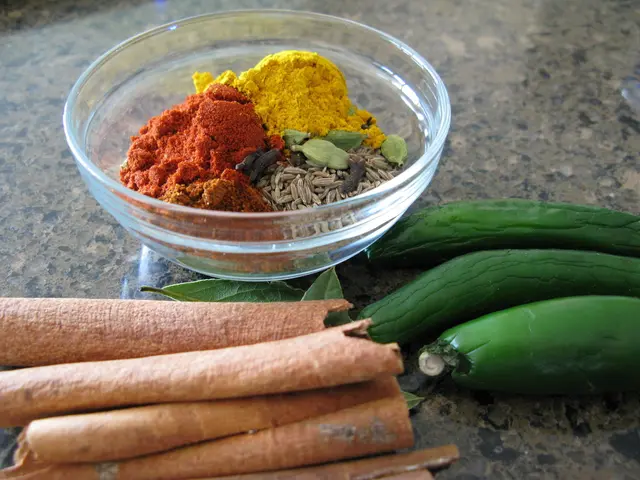13 Nutritional Options to Aid in Monitoring and reinforcing Your Menstrual Period
In the quest for a smoother menstrual cycle, certain foods can be our allies. By incorporating these nutrient-rich options into our diets, we can help reduce common symptoms such as cramps, mood swings, and bloating.
**Leafy Greens (Spinach, Kale, Fenugreek)**
Rich in iron, these greens replenish blood lost during menstruation. They also provide magnesium and vitamin K, which help reduce bloating and cramps, and combat fatigue and improve blood circulation [1][3].
**Bananas**
High in potassium and vitamin B6, bananas regulate mood and reduce water retention. They help ease bloating and muscle cramps, while their natural sugars provide an energy boost, and fiber supports digestion [1][2].
**Dark Chocolate (70% cocoa or more)**
Dark chocolate contains magnesium to relax muscles and reduce cramps. Its antioxidants and flavonoids boost mood and decrease inflammation. However, it should be low in sugar to avoid energy crashes [1].
**Salmon**
Salmon, rich in omega-3 fatty acids, offers protein and vitamin D to support hormonal health and mood stabilization [1].
**Yogurt (with live probiotics)**
Yogurt supports gut and vaginal health, reducing infection risk during menstruation. It provides calcium and vitamin D to ease cramps and calm the nervous system [1][2].
**Pumpkin Seeds**
Pumpkin seeds are packed with zinc, magnesium, and omega-3s, essential for hormone balance. They help reduce bloating, soothe cramps, and improve sleep quality [1].
Other helpful foods include whole grains, lentils, and sweet potatoes, which provide fiber-rich carbs that stabilize energy and manage cravings. Fruits high in vitamin C and fiber, such as strawberries, kiwis, oranges, papaya, aid hormone balance and digestion [3]. Water-rich fruits and vegetables like cucumber and watermelon act as natural diuretics to combat bloating [2]. Herbal teas with peppermint and ginger can soothe digestion and reduce flatulence [2].
On the flip side, processed foods, salty snacks, and carbonated beverages may worsen bloating and should be limited [2].
In summary, a balanced diet rich in magnesium, vitamin B6, iron, omega-3 fatty acids, fiber, and probiotics is crucial for menstrual health. These nutrients help reduce cramps by relaxing muscles, alleviate mood swings by supporting neurotransmitter function, and decrease bloating through improved digestion and fluid balance [1][2][3].
Turmeric, with its anti-inflammatory compound curcumin, can help reduce menstrual pain and swelling, balance hormones, and improve circulation. Sweet potatoes maintain stable blood sugar levels, important for mood and energy regulation throughout the menstrual cycle, and contain fiber that promotes digestive regularity and reduces bloating.
Embracing period power starts on your plate, focusing on smart food choices to help the body handle menstrual symptoms more smoothly.
[1] Healthline. (2021). The 12 Best Foods to Eat During Your Period. [online] Available at: https://www.healthline.com/nutrition/best-foods-to-eat-during-your-period
[2] Verywell Family. (2021). Foods to Eat and Avoid During Your Period. [online] Available at: https://www.verywellfamily.com/foods-to-eat-and-avoid-during-your-period-3524709
[3] MindBodyGreen. (2021). 10 Foods to Eat During Your Period to Reduce Symptoms. [online] Available at: https://www.mindbodygreen.com/articles/foods-to-eat-during-your-period-to-reduce-symptoms
Women can incorporate science-backed nutrient-rich foods such as leafy greens (spinach, kale, fenugreek), bananas, dark chocolate (70% cocoa or more), salmon, yogurt with live probiotics, pumpkin seeds, whole grains, lentils, sweet potatoes, and fruits high in vitamin C and fiber into healthy-diets to support womens-health and alleviate symptoms like cramps, bloating, and mood swings during their menstrual cycle. Meanwhile, avoiding processed foods, salty snacks, and carbonated beverages can help minimize bloating and improve overall health and wellness.








